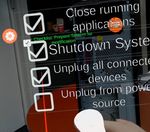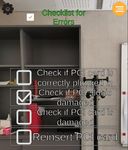Leveraging Augmented Reality to Support Context-Aware Tasks in Alignment with Business Processes
←
→
Page content transcription
If your browser does not render page correctly, please read the page content below
Leveraging Augmented Reality to Support Context-
Aware Tasks in Alignment with Business Processes
Gregor Grambow, Daniel Hieber, Roy Oberhauser, Camil Pogolski
Aalen University, Aalen, Germany
Corresponding author: Roy Oberhauser, roy.oberhauser@hs-aalen.de
Keywords: Augmented Reality – Context-Awareness – Intelligent Business Processes – Smart
Manufacturing
Abstract
The seamless inclusion of Augmented Reality (AR) with Business Process Management Systems (BPMSs)
for Smart Factory and Industry 4.0 processes remains a challenge. Towards this end, this paper contributes
an approach integrating context-aware AR into intelligent business processes to support and guide
manufacturing personnel tasks and enable live task assignment optimization and support task execution
quality. Our realization extends two BPMSs (Camunda and AristaFlow) and various AR devices. Various
AR capabilities are demonstrated via a simulated industrial case study.
1. Introduction
As Industry 4.0 digitalization grows, both business and production processes and associated IT automation
play a significant supporting role for increasingly complex scenarios. Furthermore, the integration of
industrial augmented reality (IAR) to support human tasks in production processes has remained limited, as
BPMS have hitherto not directly supported nor integrated AR. In prior work (Grambow, Oberhauser, &
Reichert, 2010, 2011), we developed an approach for contextual process management tailored towards
software engineering (SE) processes, while prior extended reality work includes (Oberhauser & Lecon,
2017), which focused on the potential of virtual reality for addressing certain SE-related challenges. This
paper contributes an approach for integrating context-aware AR into intelligent business processes, enabling
process-centric and context-aware AR support for manufacturing personnel tasks to support assignment
optimization and execution quality. Our realization via two commercial BPMSs shows its feasibility.
The paper is structured as follows: Section 2 describes related work, and Section 3 describes our solution
concept and realization. Section 4 provides an evaluation, followed by a conclusion and future work.
2. Related Work
In (Blattgerste et al., 2017), AR glasses provide mobile assistive instructions, but was largely restricted to
one concrete problem or scenario rather than a generic business process. BPMN4SGA (Vogel & Thomas,
2019) integrates Smart Glasses as a BPMN extension, but primarily for documentation purposes rather than
actionable AR content. In our approach, AR Actions are modeled and implemented via predefined AR
templates containing attributes for nearly all BPMN elements, with the AR application interpreting the
templates and sends feedback to the BPMN modeling application, avoiding implementing or syncing steps
with the BPM engine. SenSoMod (Dörndorfer et al., 2018) adds context-awareness to conventional non-
production applications like email, calendar, etc. (Gronau & Grum, 2017) combined the Knowledge
Modeling and Description Language (KMDL) with AR and projected sensor data and process step
association onto machines, but it lacks concrete tailored task guidance. BPMN4CPS (Graja et al., 2016)
combines BPMN with cyber-physical systems, adding resources and context data to a business process for
increased automation, but it does not integrate AR directly. HoloFlows (Seiger et al., 2019) is an AR process
Laval Virtual VRIC ConVRgence 2021 Proceedings - Page 17modeling approach for the Internet of Things (IoT), utilizing a simple state-machine and custom notation that
lacks BPMN support and integration with mature BPMS - vital for industrial settings.
3. Solution and Realization
As shown in Figure 1a, our overall PARADIGMA solution addresses context-awareness and AR integration
within business processes, including the user's positional data and objects of interest at that location,
gathering AR-based content input from users, integrating AR-based user choices into the local process
context, and providing AR-based guidance and prioritizes and optimizes task assignments based on context
(detailed in Grambow et al., 2021a). Our logical architecture is shown in Figure 1b, the front end is the top
layer which supports our AR app, while a BPMN app supports the modeling of AR processes with AR
support (detailed in Grambow et al., 2021b). The AR app contains the 3D models, animations, videos and
images that will be displayed in AR. The apps communicate with the PARADIGMA Backend via REST
calls, primarily using JSON-based content. This Backend, in turn, can integrate with any BPMS via REST
APIs, currently integrated with either Camunda or AristaFlow. While our solution considers many more
facets, this paper primarily elucidates the AR relevant aspects.
Figure 1: PARADIGMA Solution Approach: a) AR Context-Aware Processes and b) Logical Architecture.
For BPMN compatibility, our BPMN elements are not directly distinguishable from normal BPMN elements
without AR Actions. During modeling the distinction is made by viewing the Variables Tab for a BPMN
element in the corresponding BPMN modeling application. As shown in Figure 2, a modular system of AR
components supports various AR content-specific types, some of which we highlight below.
Figure 2: Overview of the currently implemented AR Modules.
Laval Virtual VRIC ConVRgence 2021 Proceedings - Page 18The AR Video / Image module supports video (with an alpha channel) or image (with an alpha channel)
placement in the AR world. The AR Checklist module supports task quality via checklists in AR. The 3D
Overlay module renders and positions 3D virtual objects in space.
The AR app was realized with Unity 2020.3.8f1 with AR Foundation, ARCore XR Plugin, ARKit XR
Plugin, and Magic Leap XR Plugin. It integrates REST call interaction containing JSON content with the
PARADIGMA backend (and implicitly BPMS) and handles the placement of objects in the virtual AR space.
4. Evaluation
Due to current restrictive COVID-19 industrial access, we simulated various industrial scenarios in an
analogous academic setting. Due to space constraints, only our machine modification scenario is described
here. The BPMN model for our case study is shown in Figure 3. For this scenario, an additional part (PCI
card) is added to a PC, analogous to adding or replacing a machine part in an industrial scenario. We tested
our system with a tablet (fixated by a hands-free tool) since not all workers will have access to AR goggles,
and a Magic Leap 1 as shown in Figure 3a and using its pointing device in Figure 3c. As Figure 3h shows,
checklists are spatially anchored (static) to ease reading, pointing, and checking; settings (top left) and a task
list (top right) are accessible; the active task (green) is shown with a white checkbox to its left to permit
ending the task (even if some items remain unchecked).
a) b) c) d) e)
g)
h)
f)
Figure 3: BPMN Model in Camunda Modeler annotated with AR tasks in green; a) Magic Leap b) AR
navigation support c) AR Checklist for task preparation d) AR overlay e) AR video guidance f) AR error
checklist g) AR PARADIGMA backend automatic machine sensor detection h) AR process completion checklist
The scenario process (Figure 3 Camunda BPMN with AR annotations in green) consists of the following:
1. "ask for assignment" activity: the PARADIGMA-Backend determines the optimal worker for an
assignment via our backend IAC (Intelligent Assignment Component) and assigns it to that worker.
2. User is notified of an assignment in the AR App: The upper right “Task Button” displays a red dot.
3. "Go to PC" [AR1 task]: red spheres (anchors) are used to guide the User to the destination (Figure 3b).
4. [AR2] Displays a checklist (Figure 3c) for system hardware modification preparation (Figure 3d).
Laval Virtual VRIC ConVRgence 2021 Proceedings - Page 195. [AR3] An AR-Video-Overlay is shown on how to open up a PC case (Figure 3e). Once the marker
inside the PC is scanned, the video stops and a 3D PCI Card and mainboard overlay is shown (Figure
3d). The user ends the AR task by selecting the checkmark next to the active task.
6. [AR4] The user waits (Figure 3g) for PARADIGMA context sensors to detect PC and PCI card.
7. [AR5] If undetected or a timeout occurs, an Error Checklist is shown (Figure 3f) and [AR4] is repeated.
8. [AR6] PCI Card was “detected” so the completion checklist (Figure 3h) is shown. Once all items or
task is checked, the activity and process are ended and PARADIGMA provides the next assignment.
5. Conclusion
Towards improving IAR and Smart Factory and Industry 4.0 process integration, we contributed a context-
aware approach for IAR modeling and integration that aligns business processes with worker situations and
global and local industrial context. It contextually integrates process-based guidance and support for
manufacturing personnel tasks, live task assignment optimization, and improved task execution quality. Our
realization via integration with two BPMSs and various AR devices showed its feasibility. Our evaluation
case study demonstrated primary IAR capabilities. Future work includes automatically determining the
expertise of an AR user (e.g., based on errors and/or performance and guidance usage) and auto-adjusting the
guidance appropriately; integrating additional hand-tracking and gesture detection mechanisms; improving
AR marker recognition; supporting manual process task jumps to previously completed activities; supporting
task preview mode; addressing AR darkness/light condition sensitivity for object positioning; and a
comprehensive empirical study in an industrial setting.
6. Acknowledgments
Funding for the project PARADIGMA related to this paper was received from ZIM, a funding program of
the Federal Ministry for Economic Affairs and Energy of the Federal Republic of Germany.
7. References
Blattgerste, J., Strenge, B., Renner, P., Pfeiffer, T., & Essig, K. (2017). Comparing Conventional and
Augmented Reality Instructions for Manual Assembly Tasks. Proceedings of the 10th International
Conference on PErvasive Technologies Related to Assistive Environments - PETRA ’17, 75–82.
Dörndorfer, J., Seel, C., & Hilpoltsteiner, D. (2018). SenSoMod–A modeling language for context-aware
mobile applications. Multikonferenz Wirtschaftsinformatik (MKWI), 1435-1446.
Graja, I., Kallel, S., Guermouche, N., & Kacem, A. H. (2016). BPMN4CPS: A BPMN Extension for
Modeling Cyber-Physical Systems. IEEE 25th International Conference on Enabling Technologies:
Infrastructure for Collaborative Enterprises (WETICE), 152–157.
Grambow, G., Oberhauser, R., & Hieber, D. (2021a). Intelligent Task Assignment in Industry 4.0 Production
Processes Utilizing Fuzzy Sets. Tenth International Conference on Intelligent Systems and Applications
(INTELLI 2021). IARIA. To be published.
Grambow, G., Oberhauser, R., Hieber, D., & Pogolski, C. (2021b). Supporting Augmented Reality Industry
4.0 Processes with Context-aware Processing and Situational Knowledge. Thirteenth International
Conference on Information, Process, and Knowledge Management (eKNOW 2021). IARIA. To be
published.
Grambow, G., Oberhauser, R., & Reichert, M. (2010). Towards automated context-aware software quality
management. Fifth International Conference on Software Engineering Advances. IEEE. pp. 347–352.
Grambow, G., Oberhauser, R., & Reichert, M. (2011). Contextual injection of quality measures into software
engineering processes. International Journal on Advances in Software, 4(1&2), 76–99.
Gronau, N., & Grum, M. (2017). Integration of Augmented Reality Technologies in Process Modeling—The
Augmentation of Real World Scenarios With the KMDL. 206–215.
Oberhauser, R., & Lecon, C. (2017). Gamified Virtual Reality for Program Code Structure
Comprehension. International Journal of Virtual Reality, 17(2).
Seiger R., Gohlke M., Aßmann U. (2019) Augmented Reality-Based Process Modelling for the Internet of
Things with HoloFlows. In: Enterprise, Business-Process and Information Systems Modeling. BPMDS
2019, EMMSAD 2019. LNBIP, vol 352. Springer, Cham.
Vogel, J., & Thomas, O. (2019). Generating Smart Glasses-based Information Systems with BPMN4SGA: A
BPMN Extension for Smart Glasses Applications. Wirtschaftsinformatik 2019 Proceedings.
Laval Virtual VRIC ConVRgence 2021 Proceedings - Page 20You can also read

























































